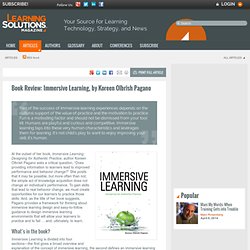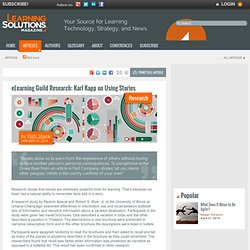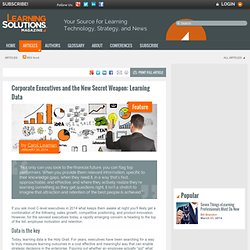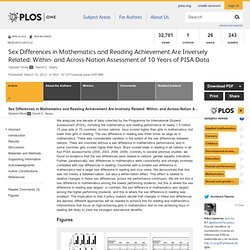

Seven Things eLearning Professionals Must Do Now by Bill Brandon. Brain Science: The Forgetting Curve–the Dirty Secret of Corporate Training by Art Kohn. “Your brain needs to forget things that are no longer useful.

And this forgetting is inevitable, it is useful, and it is adaptive because it clears your memory for things that are more relevant. The problem, however, is that in the process of all of this memory purging, our brain often forgets important information.” Imagine you’re put in charge of your company’s biggest leadership training program. You do everything right: you conduct extensive discovery with your subject-matter experts, you spend weeks authoring the storyboard, your executive team signs off, and you deliver a stellar training experience. Everything goes beautifully and everyone agrees the training was a huge success. But back in your office, while you bask in the glory of your success, a dreadful thing is happening inside the brains of your students.
Are You Ready to Deliver Personalized Learning? by Ruth Kustoff & Kasper Spiro. “Learning has become mobile and on demand.

Learning knows no place or boundary; it can be on the go, in the office, at home, or anywhere. Learners can now ‘pull’ the information they need, when they need it, shifting control from training departments to the learner.” Training organizations are moving toward an ideal: personalized learning. However, there is little agreement about what “personalized learning” means. In this article, we examine what personalized learning is in the corporate environment and how organizations can prepare to meet this new learning need. Everyday personalization There are several ways to define the concept.
Book Review: Immersive Learning, by Koreen Olbrish Pagano by Jennifer Neibert. Part of the success of immersive learning experiences depends on the cultural support of the value of practice and the motivation to practice.

Fun is a motivating factor and should not be dismissed from your tool kit. Humans are playful and curious and competitive. Immersive learning taps into these very human characteristics and leverages them for learning. It’s not child’s play to want to enjoy improving your skill; it’s human. At the outset of her book, Immersive Learning: Designing for Authentic Practice, author Koreen Olbrish Pagano asks a critical question, “Does providing information to learners lead to improved performance and behavior change?” Marc My Words: The Training to Competence Myth by Marc J. Rosenberg. “Training no longer works in isolation.

The transition from classroom (or an online experience) to the workplace must be seamless. This adds design decisions that transcend instruction. The Cost of E-Learning. "How much will it cost?

" It's one of the first questions asked by anyone looking to start an online program. The answer, of course, is neither easy nor straightforward. E-learning is a business activity. It has a value to the business, a start-up cost, and running costs. The costs must be managed if the program is to stay within budget and yield an adequate return on investment. The question of start-up versus ongoing costs can best be answered if the program scope can be defined for the first two or three years. Expenses include the software applications used to create the online presence, establish management functions, create the courses, and enable their delivery. The Elusive ROI for Learning Through Technology by Jack Phillips & Patti Phillips.
“ROI for learning through technology can be an elusive number, but it does not have to be.

By following some prescribed steps, designers and developers can make a huge difference in the success of eLearning, pushing it to impressive levels of success for application and impact.” Few would dispute the convenience, low cost, and high efficiency of learning through technology. Whether eLearning, blended-learning, or mobile learning, it is usually just in time, just enough, and just for the user, which is the ideal form of customization and convenience for participants. At the same time, for larger audiences, eLearning represents a tremendous cost savings. Executives have learned to love eLearning for its convenience, its timeliness, and its low cost. Some professionals measure the ROI for eLearning on the basis of cost savings alone, comparing eLearning to the facilitator-led counterpart. The challenge Types of data. eLearning Guild Research: Karl Kapp on Using Stories by Patti Shank. “Stories allow us to learn from the experience of others without having to face another person’s personal consequences.

To paraphrase writer Drake Baer from an article in Fast Company, stories ‘let you demo other peoples’ minds in the comfy confines of your own.’” Research shows that stories are extremely powerful tools for learning. That’s because our brain has a natural ability to remember facts told in a story. A research study by Rashmi Adaval and Robert S. Wyer, Jr. at the University of Illinois at Urbana-Champaign examined differences in information use and recall between bulleted lists of information and narrative information about a vacation destination. Participants were assigned randomly to read the brochures and then asked to recall and list as many of the places or situations described in the brochure as they could remember. The Guild’s new Big Answers report, Using Stories for Learning: Answers to Five Key Questions, describes this kind of research and its implications. Corporate Executives and the New Secret Weapon: Learning Data by Carol Leaman.
“Not only can you look to the financial future, you can flag top performers.

When you provide them relevant information, specific to their knowledge gaps, when they need it, in a way that’s fast, approachable, and effective, and where they actively realize they’re learning something as they get questions right, it isn’t a stretch to imagine that attraction and retention of the best people is achieved.” If you ask most C-level executives in 2014 what keeps them awake at night you’ll likely get a combination of the following: sales growth, competitive positioning, and product innovation.
However, for the savviest executives today, a rapidly emerging concern is heading to the top of the list: employee motivation and retention. Data is the key Today, learning data is the Holy Grail. If Training Is So Important, Why Can't I Get the Funding I Need? by John Sadowski. “You need to be proactive in promoting learning as a strategic resource.

But in order to do that, you need to build a case around the ROI values achieved through learning. Raise the visibility of your department’s accomplishments and justify new strategic directions based on delivering results.” Jack Welch, famed international business leader and CEO of General Electric once said, “An organization’s ability to learn and translate that learning into action rapidly is the ultimate competitive advantage.” If learning is so important, why do most training professionals struggle to get the funding they need? That’s a good question, and one I will explore in this article. Sex Differences in Mathematics and Reading Achievement Are Inversely Related: Within- and Across-Nation Assessment of 10 Years of PISA Data. We analyzed one decade of data collected by the Programme for International Student Assessment (PISA), including the mathematics and reading performance of nearly 1.5 million 15 year olds in 75 countries.

Across nations, boys scored higher than girls in mathematics, but lower than girls in reading. The sex difference in reading was three times as large as in mathematics. There was considerable variation in the extent of the sex differences between nations. There are countries without a sex difference in mathematics performance, and in some countries girls scored higher than boys. Boys scored lower in reading in all nations in all four PISA assessments (2000, 2003, 2006, 2009). Figures. Sustaining Students: Retention Strategies in an Online Program (EDUCAUSE Quarterly) Key Takeaways With students spread across 47 states and a dozen countries, the University of Illinois at Springfield faces a significant challenge in promoting student persistence.
IMS Global Learning Consortium: Interoperability Standards for Education by Bill Brandon. “The IMS Global Learning Consortium (IMS GLC) is a global, nonprofit, member organization that strives to enable the growth and impact of learning technology in the education and corporate sectors worldwide.”— IMS profile statement Standards for interoperability are increasingly important as platforms, applications, systems, and technologies for learning and education proliferate. Many readers of this magazine are already familiar with SCORM and the Experience API (xAPI), learning management systems (LMSs), and Learning Record Stores (LRSs) because of the attention that government and corporate organizations have given them.
But what about the education field? The challenges for communicating information and for application compatibility become even greater there as educators strive to comply with national and state initiatives, such as (in the United States) Race to the Top and Common Core. Metrics that Matter® Demos. You’ve got a lot riding on your talent. Are you sure they’re headed in the right direction? Are your talent development programs effective? Is there anything you can do to improve? You can’t manage what you can’t measure, and what you don’t know could be hurting your business. Enter Metrics that Matter®. Metrics that Matter® combines a world-class evaluation system with powerful analytic tools to help organizations measure and improve their talent development programs.
3 Reasons Videos Go Viral: YouTube’s Kevin Allocca at TEDYouth. At a recent TEDYouth event, Kevin Allocca, YouTube’s Trends Manager (i.e., he gets paid to watch and analyze YouTube videos) explained why, despite 48 hours of video being uploaded to YouTube every minute, certain videos go viral and often become cultural phenomenons (dare we remember Rebecca Black’s “Friday” or, more recently, PSY’s “Gangnam Style“?). While his talk focused primarily on videos that HR would prefer we watch outside of work, the trends he explores are very much relevant to the videos that communicators are being asked to create and/or publish more and more frequently.
In particular, he notes that the majority of videos that spread like wildfire among a given audience possess at least one of three traits: 1) Unexpectedness Here’s a question for you: Why have over six million people viewed a video on YouTube of a man proving how unsafe the bike lanes can be in New York City by riding his bike in the aforementioned bike lanes?
2) Tastemakers 3) Communities of Participation. Introducing Personal Knowledge Management (PKM) to a Corporate Audience by Eric Kammerer. “Learners want some guidance about the changing boundaries of professional development. K-12 Education & Learning Innovations with Proven Strategies that Work. K-12 Education & Learning Innovations with Proven Strategies that Work. MinecraftEdu. Marc My Words: Don't Dismiss Level One Evaluation by Marc J. Rosenberg. “If you are collecting Level One data, be smart about it. Don’t gather so much information from participants that you drown in it, ignore it, or dilute the survey so much that you lose sight of its most important point— measuring the worthiness of your efforts.” Many training pros disparage Kirkpatrick’s Level One evaluation.
I’m not one of them. Types of Blended Learning [INFOGRAPHIC] Many organizations are realizing the inherent benefits of utilizing a robust blended learning approach to their learning initiatives, in fact, by 2019, 50% of all high school courses will be delivered online. Flipped-Classroom: Future of Education? [INFOGRAPHIC] New technology is opening new doors in classrooms all over the world as more teachers are using a flipped classroom model to deliver their content.
Blended Learning. The Best K-12 Education Technology Blogs. If it takes a village to raise a child, how many people does it take to train an educator? 5-Steps for Creating Effective Employee Training. Marc My Words: Back to School (Killing and Reigniting the Learning Flame) by Marc J. Rosenberg.
Putting Out Fires, Part 4: Setting eLearning Standards by Jennifer De Vries & Joe Ganci. “We all follow standards, whether we realize it or not. If we can document the standards that we used in each project, then someone who comes after us will be more likely to revise our courses in the intended style” Why Big Data, Not MOOCs, Will Revolutionize Education. Massive open online courses, or MOOCs, are hailed as a new innovation so disruptive for academia today that they will do to higher education what the Internet has done to newspapers or what Napster did to music. Do Universities Think Online Education is the Future? Does eLearning Work? It's Time to Put This Question Behind Us. E-Learning Bookmarking Service - e-Learning Tags - Your Source for Social News and Networking.
Our Three eSteps to Lasting Behavioral Change by Mukta Raut. Mobile Learning Supports Global Health by Inge de Waard. Leveraging the E-Learning Advantage in Healthcare by Peggy Salvatore. Research for Practitioners: When It's Not a Knowledge Problem by Julie Dirksen. Our Three eSteps to Lasting Behavioral Change by Mukta Raut. Build a Dream Team for Your eLearning Project by Steven Loomis.
Show Me the ROI! by Conrad Gottfredson. Once Again, Games Can and Do Teach! by Karl Kapp. Once Again, Games Can and Do Teach! by Karl Kapp. How to Engage Learners with Scenario-based Learning by Hans Kövi & Kasper Spiro. “Big Data” and What it Will Mean for Maritime Training: “The Art of the Possible” Why Games Don't Teach by Ruth Clark. How to Engage Learners with Scenario-based Learning by Hans Kövi & Kasper Spiro.
Development of Product Training courses using e-LearningSwift ELearning Services. Game Architecture: Delivering Meaningful Learning Experiences by Mayra Aixa Villar. 50 Best eLearning Posts Of 2012. Dr Najeeb - Case Study. Maria Ginsbourg. Book Review: 100 Things Every Online Student Ought to Know by Bill Brandon. A Baker’s Dozen Tips for Getting the Most From an Online Course. Animation – Relevant & Fun! The Learning Curve. Learning Technologies. Is it Time for a Change? The Environment Model by Neil Lasher. Rapid E-learning Processes. Elearning Tips. Checklist: How to plan/scope your e-learning project. How to structure your e-learning project plan. From Training to Enhanced Workplace Performance.
The Fallacy of ROI Calculations. Articles / Papers. Technologies for info. professionals. The Trouble With Online Education. Google+ Hangouts in Online Education: A Capable, Low-Cost Solution by Rebecca Bodrero. In a Relationship: College Students and Their Smartphones [INFOGRAPHIC] Learning on the Job: Myth vs Science. The difference between live and taped lectures - The Answer Sheet. The Evolution of Gamification in the Workplace. Mobile Migration: Why Your Training Content Belongs in the Cloud by Dawn Poulos. Ten Things You Need To Know About Managing Knowledge.
Writing Copyright Statements for eLearning by Saul Carliner. Some Thoughts On Tablet Learning (aka Elearning On iPads) Is Content Curation in Your Skill Set? It Should Be. by David Kelly. The Learned Man. Performance Support. Strategies, Models and Guidelines to use eLearning in SMEs. Knowledge Factor.